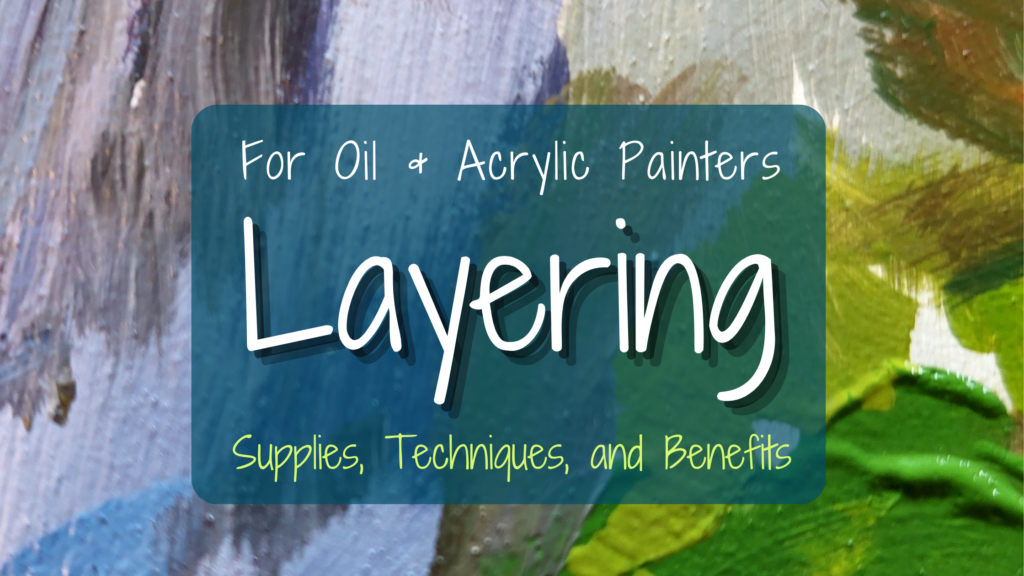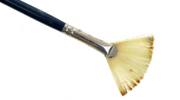Layering is a fundamental technique in opaque painting, where the application of multiple layers of paint on top of each other can create depth, dimension, and richness in a painting. Whether you’re working with oil, acrylic, or any other opaque medium, layering can be a powerful tool.
The first step in layering is to determine your desired final effect. This could be anything from a smooth, even coverage to a heavily textured surface. From there, you can start building your layers as needed. For a smooth look, begin by applying thin, transparent washes of paint to the surface. As each layer dries, you can then add additional layers of paint, gradually building up the intensity and opacity of the color.
Supplies: Brushes
The right brush for the job is essential for layering. If you have stiff bristles, they will push the paint around, rather than blend. Both of these effects are useful, so there isn’t a right or wrong way, just a needed awareness to get the results you want.
Fan brushes – many artists swear these are the thing for blending. I never quite seemed to be able to get the hang of this one without looking like a Bob Ross painting. Feel free to let me know your fan brush thoughts below.
Supplies: The Surface
If you want as smooth a surface as possible, you will probably want to paint on a smooth, hard surface such as a wood panel. In art school, I knew a guy who could make the most smooth canvases of all time. He had like 6 layers of sanded gesso coats. It was amazing. But, I often wondered what the point was? Why not just paint on panel?
Benefit: Depth
One of the benefits of layering in opaque painting is that it allows you to create depth and dimension in your painting. By applying multiple layers of paint, you can create a sense of recession and foreground, making the elements in your painting appear to recede into the background or come forward into the foreground. There is also something incredibly special about paint itself. Layers of translucent-to-opaque paint creates an effect that is not fully understood until seen in person. There is a depth to the physical material itself, that printers just cannot replicate (at least not yet).
Benefit: Texture
Layering can also be used to create physical texture in a painting. For example, by applying a thick, textured layer of paint over a smooth, flat surface, you can create a textured effect. This can be especially useful for creating the illusion of rough surfaces, such as rocks, or tree bark.
Benefit: Freedom
Another benefit of layering is that it allows you to work on your painting over time, making changes and adjustments as you go. For example, if you’re not happy with the way a certain area of your painting is turning out, you can easily paint over it with a new layer of paint, adjusting the color or texture as needed. Can you try and imagine an abstract (non-objective) painting without the freedom given by layering?
Supplies & Technique: Glazing
Glazing is technique of layering in painting that creates a sense of luminosity and transparency. By applying thin, transparent washes of paint over a darker layer, you can create a sense of light shining through the upper layers, giving the painting a luminous, glowing effect. This is done with adding glazing mediums in acrylic paint, or oil in oil paint. It is easier to do with a transparent color (for example, use zinc white** instead of titanium white).

In this copy of Goya’s Plague Hospital, I recreated the soft sunlight beam with many layers of glazed white.
Glazing was an essential technique for many centuries, but isn’t always used in contemporary art. Artists such as Vermeer used glazing as an affordable way to bring color to paintings, and a great way to add texture.
“Vermeer consciously varied the consistency of his paint to achieve particular effects. For example, he used paint of a consistency that retains the impression of the brush in both underpaint and sections of high impasto to provide light-catching texture while a more fluid application could suggest silky surfaces” -The National Gallery, London. (Link to article.)

Girl with a Pearl Earring, Johannes Vermeer, painted with both glazing to create smooth surfaces and scumbling to create the textures of the cloth.
Technique: Impasto & Scumbling
Impasto is simply the application of a thick layer of paint. Scumbling is like glazing, but without the medium. It is applying a layer (brushstroke) of opaque paint. The layer underneath can still come through in bits. It is also referred to as the “dry brush technique” due to the lack of medium. Think of Claude Monet and all his brushstrokes that built up colors and textures.
Layering is a powerful technique in opaque painting that can be used to create depth, dimension, texture, and luminosity in your paintings. Whether you’re just starting out or are an experienced painter, layering can be a valuable tool to help you achieve your desired results. So, give it a try and see what you can create! Happy painting!
** Note: Zinc white is a great white for transparency, but has cracking tendencies in oil paint. It isn’t a problem in acrylics. For a quick demo on the differences between zinc and titanium whites: Titanium verses Zinc White (YouTube)
Other resources:
These links go to DickBlick.com. They are my affiliate links where you pay the same as you normally would, and also help support this content. I appreciate your support. I only recommend products that I use and believe in recommending.
Brushes – I really like the Silver Brush Bristlon Synthetic Brushes. They can do impasto and blending. Although, if you really want to smooth out every stroke, you may want a softer bristle. Look for words like “soft” when shopping.
Ampersand Gessobords – Amazing smooth surface panel. Can be used with paint, or encaustic.
or the Blick Wood Boards (and then you can gesso them yourself).





